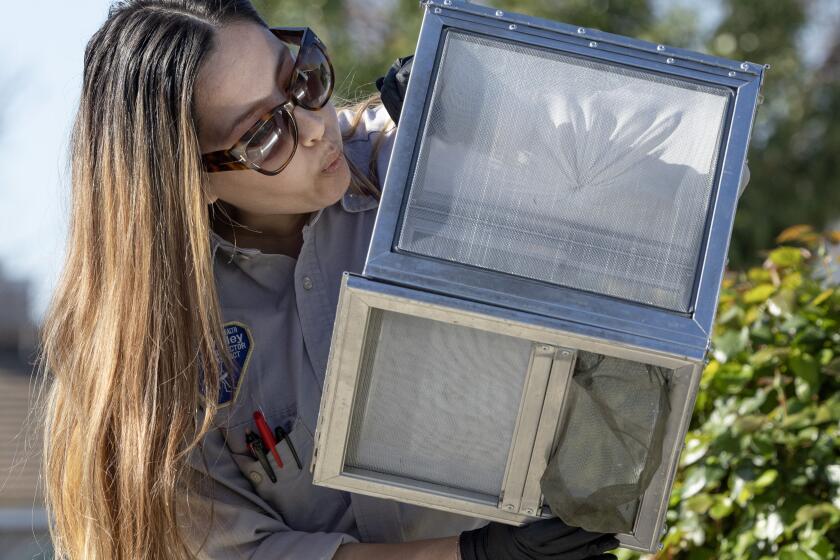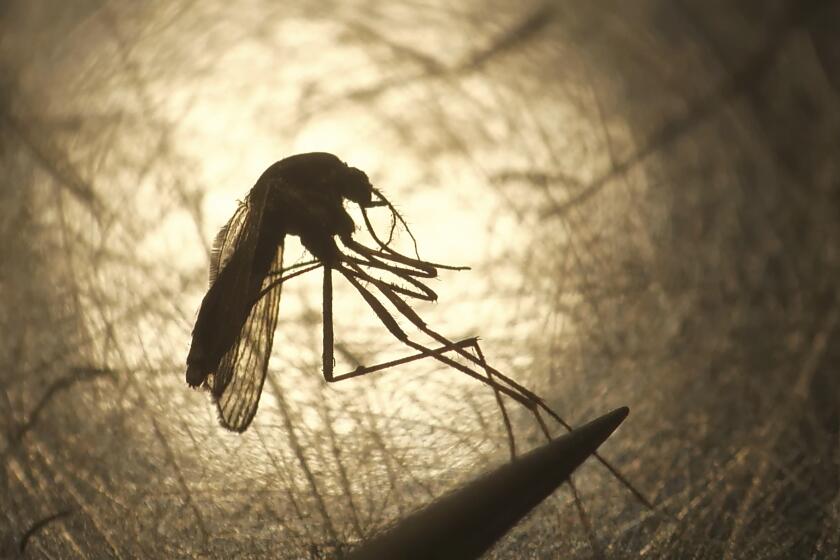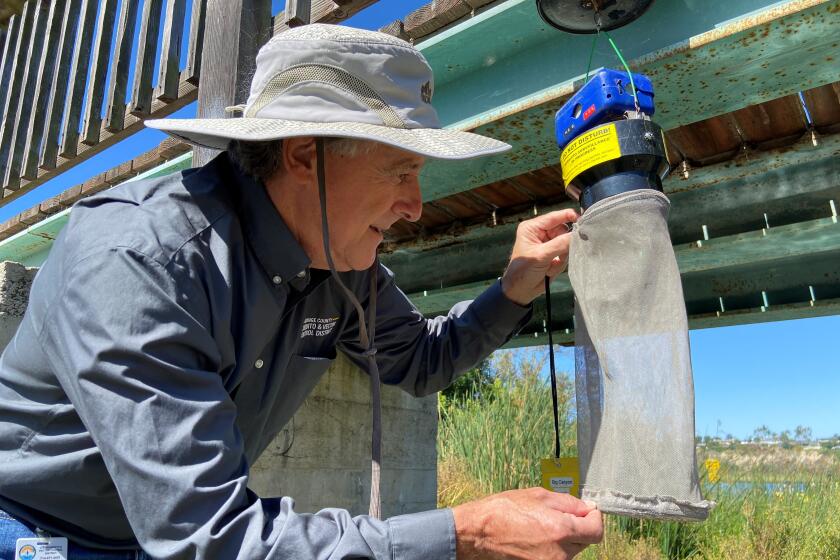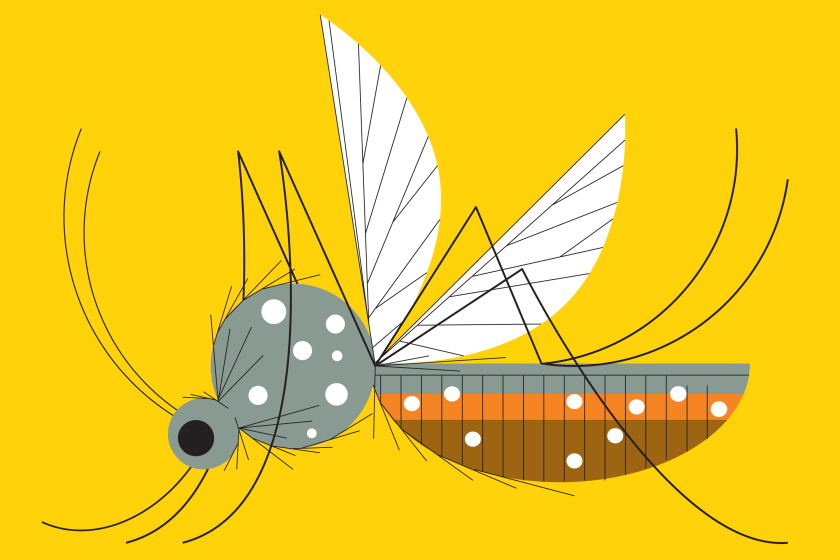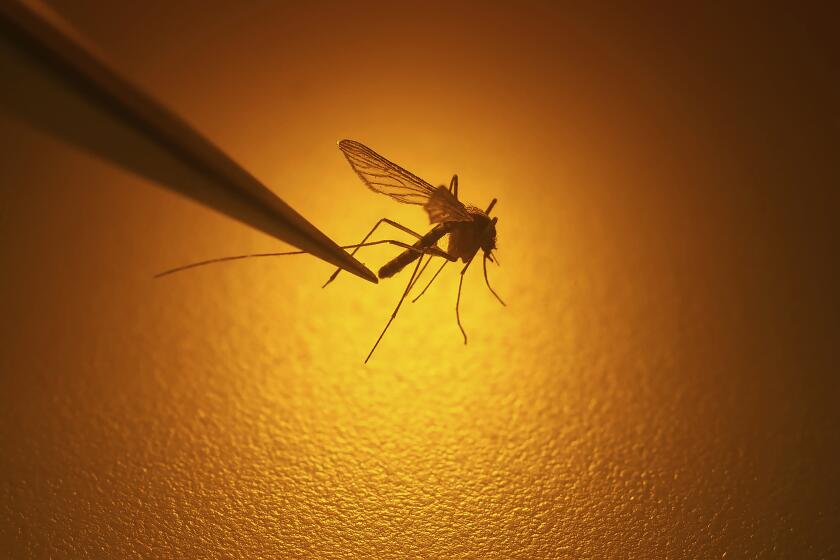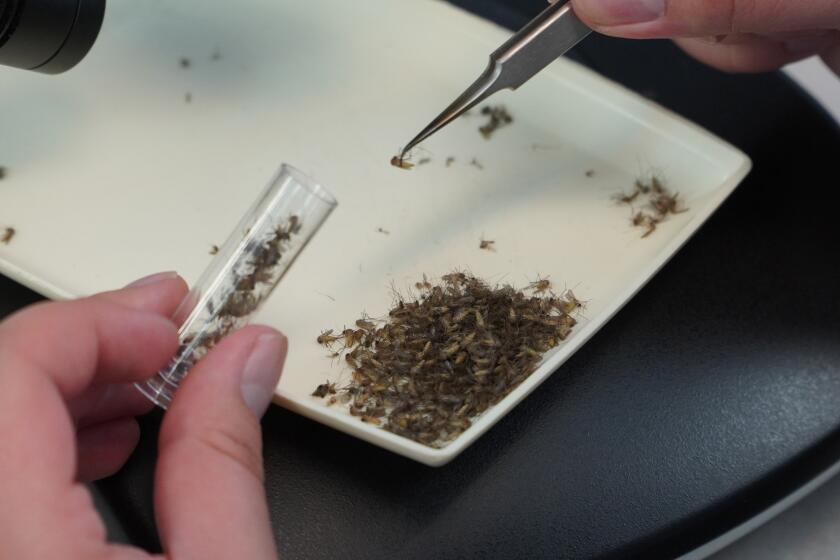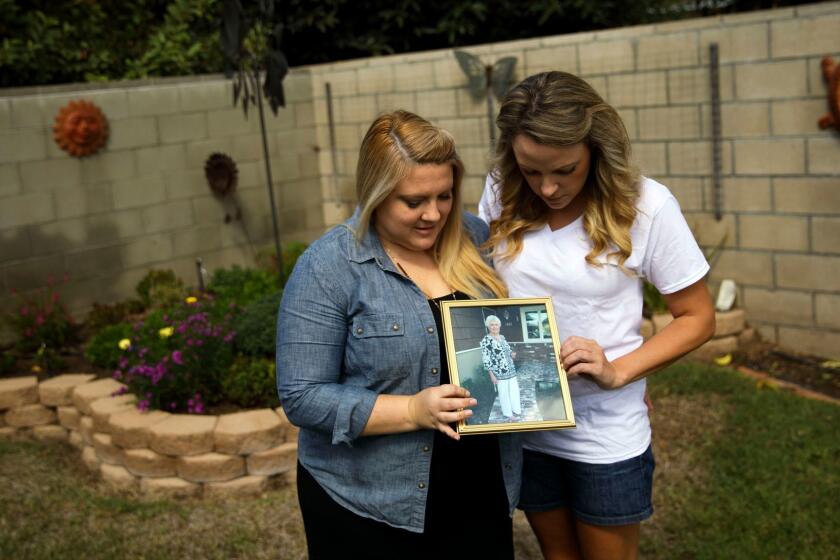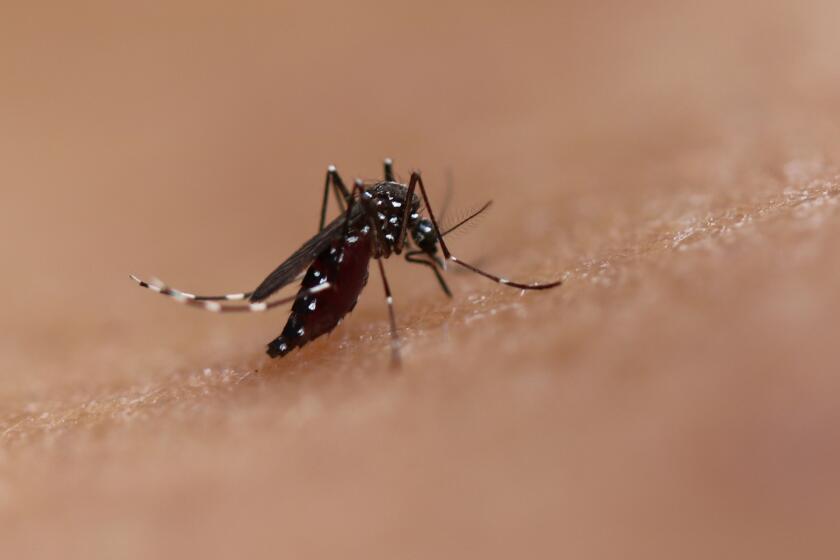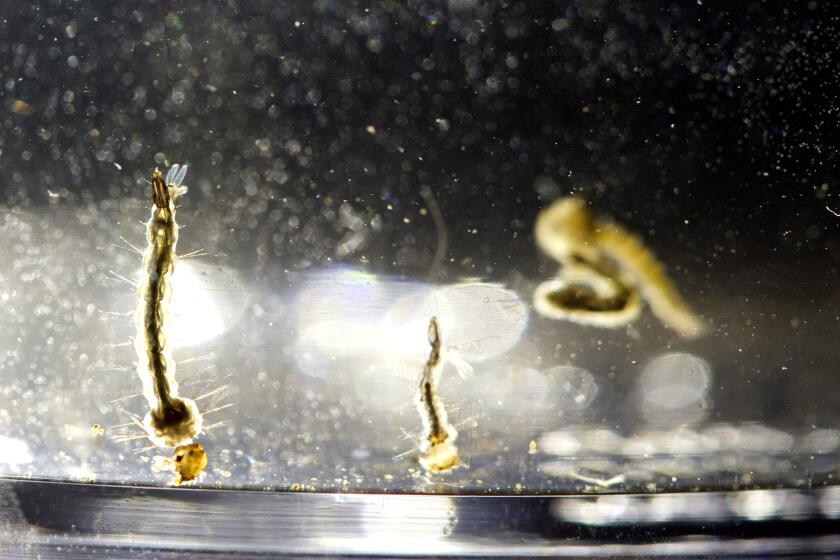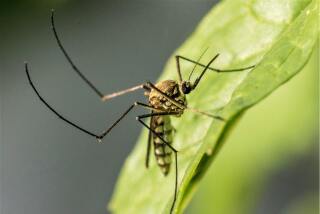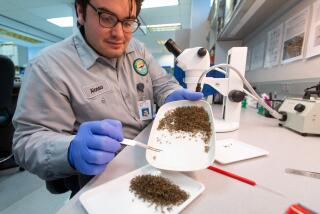Mosquito-borne virus spreads at ‘unprecedented’ levels in L.A. Climate change may make things worse
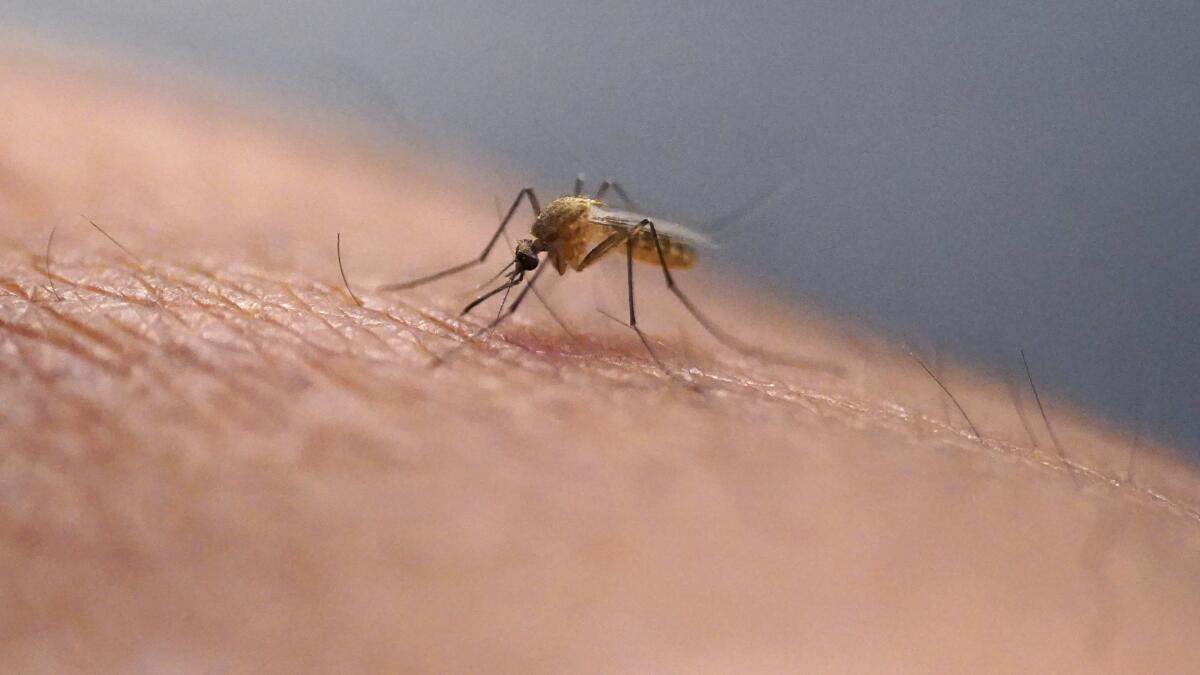
- Climate change is exacerbating the risk of potentially dangerous mosquito-borne diseases in California.
- Dengue, the world’s most common mosquito-borne illness, is not transmitted directly from insect to insect. Mosquitoes pick up the virus after they bite an infected person, then spread it by biting others.
Climate change is exacerbating the risk of potentially dangerous mosquito-borne diseases in California — threatening to turn more of those annoying-but-harmless bites into severe illnesses, experts say.
California already grapples with West Nile virus, a potentially deadly disease that was first detected in the state about two decades ago. But officials are now warning of a potential new foe: dengue, a viral infection that in the most serious cases can also lead to life-threatening complications.
Until last year, all dengue cases reported in California were associated with people traveling to a country where the disease is common. But Los Angeles County public health officials are now warning about the “unprecedented” local transmission of dengue, which is commonly found in tropical and subtropical climates.
Just this month, the county Department of Public Health has reported four cases of locally acquired dengue — meaning people were infected in their communities, not while traveling. Three were documented in the San Gabriel Valley city of Baldwin Park; the latest was reported Wednesday in Panorama City, about 30 miles to the northwest.
Vector control officials in Southern California are starting to release sterilized male mosquitoes to combat the summertime onslaught of ankle biters.
“While the widespread transmission of dengue remains low, we do urge residents ... to take simple steps to reduce exposure to mosquitoes. These include using insect repellent to prevent mosquito bites,” L.A. County Public Health Director Barbara Ferrer said at a recent news conference.
Dengue, the world’s most common mosquito-borne illness, is not transmitted directly from insect to insect. Mosquitoes pick up the virus after they bite an infected person, then spread it by biting others, according to Jason Farned, district manager of the San Gabriel Valley Mosquito and Vector Control District.
The worry, though, is “if there are enough infected mosquitoes, it could lead to exponential spread,” said Dr. Aiman Halai, director of the L.A. County Department of Public Health’s Vector-Borne Disease Unit.
“When we see local cases here, we want to act on them really quickly, identify additional cases in that area if there are, and work with our vector-control partners to control the mosquito populations rapidly so that it doesn’t spread,” Halai said.
April showers bring ... mosquitoes. Here are some pointers to help keep them away from your home. Pro tip: Do not leave pools of standing water on your property.
Officials are hoping to eradicate local reservoirs of dengue by reducing mosquito populations and eliminating possible breeding sites, namely containers that hold water.
Last October, officials announced the first-ever confirmed case of dengue in California not associated with travel — in a resident of Pasadena. Another locally acquired case was reported in Long Beach about two weeks later.
West Nile virus was first documented locally a generation ago, in 2003.
Climate change is contributing to the spread of these invasive, non-native mosquito-borne diseases, experts say. The World Health Organization warned last year that global warming “marked by higher average temperatures, precipitation and longer periods of drought, could prompt a record number of dengue infections worldwide.”
A woman tested positive for the West Nile Virus infection, becoming the first human case in Orange County this year, according to health officials.
The U.S. Environmental Protection Agency has also said that climate change increases the risk of exposure to West Nile virus, as warmer temperatures can accelerate mosquito development, biting rates and incubation of the disease within an insect. Mild winters and drought have also been associated with West Nile virus outbreaks, the EPA said.
It was only about a decade ago that the invasive mosquito species Aedes aegypti was first found in California, shocking officials. That species can transmit dengue, as well as other viruses, namely yellow fever. Aedes aegypti was found in the Central Valley in 2013 and in Los Angeles County the following year.
Aedes aegypti has now been identified throughout Southern California, including in San Diego, Orange, Riverside, San Bernardino, Ventura and Imperial counties; as well as in Sacramento, Fresno and Kern counties.
The species has also been found as far north as Butte, Shasta and Glenn counties, according to the California Department of Public Health. At least three counties in the San Francisco Bay Area — Santa Clara, Contra Costa and Solano — have found Aedes aegypti this year.
Have you experienced an unusual number of mosquito bites this summer?
As the California Office of Environmental Health Hazard Assessment notes, “A changing climate may create conditions favorable for invasive mosquito species to expand their geographic range into California.”
Aedes aegypti is considered more likely than another type of Aedes mosquito, Aedes albopictus, to spread viruses like dengue, according to the U.S. Centers for Disease Control and Prevention. Aedes albopictus, also known as Asian tiger mosquitoes, arrived in L.A. County in 2001 and have since drawn complaints about their unusually aggressive, daytime biting. (Aedes aegypti also bite during the day.)
Besides California, other states that have also reported limited local spread of dengue are Texas, Florida, Arizona and Hawaii. Health officials in Puerto Rico declared a dengue outbreak in March.
Cases of dengue have “grown dramatically around the world in recent decades,” the WHO says. The number of cases reported globally has grown from about 500,000 in 2000 to more than 6.5 million in 2023, a record.
“Dengue is at a record high around the world,” Farned said. “And so, as there are more dengue infections in other places in the world [and] people who are traveling in and out of L.A. County, there’s an increased risk that someone may bring the virus back and get bit by one of our local mosquitoes.”
Everything you need to know to protect yourself from mosquitos while hiking and camping in Southern California.
Dengue cases are underreported because most are asymptomatic or mild, officials say.
But the mosquito-borne disease isn’t toothless. About 1 in 20 people who become infected with dengue will become seriously ill, suffering shock, internal bleeding, organ impairment or respiratory failure.
Those at highest risk for severe illness are babies, pregnant people, seniors age 65 and up and people with certain medical conditions.
More than 7,300 dengue deaths were reported globally in 2023.
“Any infection can cause severe disease,” Halai said.
Los Angeles County has detected mosquitoes carrying the West Nile virus for the first time this year.
Other possible symptoms include high fever, severe headache, pain behind the eyes, joint and muscle pain, rash and bleeding.
Severe dengue is a medical emergency, and people with the following symptoms should immediately go to the emergency room: belly pain or tenderness, vomiting at least three times in 24 hours, bleeding from the nose or gums, vomiting blood, blood in the stool or feeling extremely tired or restless, according to the CDC. Signs of severe dengue usually begin to appear in the 24 to 48 hours after a fever has gone away.
Throughout California, 250 dengue cases were reported in 2023. All of those were associated with out-of-state travel, except for the cases in Pasadena and Long Beach. The tally was the highest since 2019’s total of 267.
At least 151 cases of dengue have been reported this year in California, including the cases in Baldwin Park and Panorama City.
Mosquito season has arrived in Southern California, along with the threat that these insects could carry a number of dangerous diseases.
There are four dengue viruses that are closely related, but distinct. Infection from one usually leads to lifelong immunity from that specific dengue virus, and short-term cross-protective immunity from the others, Halai said.
But this also means that a person who has recovered from their first dengue infection can get infected a second time. And a second infection raises the risk of severe disease, Halai said.
There is no antiviral medication for dengue.
Exacerbating the risk is that mosquito season is generally starting earlier and ending later — potentially running from March all the way through October, according to Farned.
A woman tested positive for the West Nile Virus infection, becoming the first human case in Orange County this year, according to health officials.
Aedes aegypti, however, tend to peak a little bit later than other mosquito populations, with maximum activity from August through October. The season ends when nighttime temperatures drop below 50 degrees, essentially too cold for them to reproduce.
“As soon as the nighttime temperatures are consistently in the 40s or low 50s, we see mosquito populations crash,” Farned said. The mosquitoes are still around in winter, but disease prevalence and nuisance biting generally goes away.
Aedes aegypti prefer to live near humans, in cities, Farned said.
“We find them mostly in backyards, growing in very small containers ... from buckets to flower pots, old tires,” he said. “The more water that can fill these containers through sprinklers and other ways will grow more mosquitoes. And the more foliage that you have and the more shade that you have will allow places for these mosquitoes to rest and be comfortable.”
Julie Shepherd ended up in the hospital earlier this month after her neighbor found her on the floor of her West Covina home, unable to move.
Yards with sparse vegetation or drought-tolerant landscaping are less inviting.
Mosquitoes can breed even in the small amount of water that collects in a bottle cap, and only need five to seven days to grow from egg to adult, Farned said.
Mosquito eggs can last for more than a year without water, according to Santa Clara County. Aedes aegypti “feeds almost exclusively on humans and does not fly long distances, venturing fewer than 500 feet from where it hatches,” county officials said.
That county, Northern California’s most populous, is aiming to eradicate Aedes aegypti when they are discovered. Painstaking attempts to eliminate them are underway in a neighborhood of East San José and in Gilroy.
“If Aedes aegypti gains a foothold in Santa Clara County, it will not only threaten public health but also affect our quality of life, as these mosquitoes are highly aggressive and active during the day, unlike native mosquito populations, which are most active in the morning and evening, when temperatures are cool,” Santa Clara County said in a statement.
Since getting a foothold in L.A. County a decade ago, the aggressive Aedes mosquito has expanded rapidly. It has been found from Laguna Beach to Santa Clarita.
Residents can disrupt Aedes aegypti by dumping any standing water in their yards at least once a week, and tossing any unused containers.
Other sources of water that should be regularly emptied include pet dishes, fountains, bird bath, plant pots and saucers, according to Santa Clara County. Scrubbing bird baths and pet dishes can also help remove lingering Aedes aegypti eggs, which look like tiny bits of dirt and are about a half-millimeter in size.
Rain barrels should be properly screened or covered to prevent mosquito access, broken sprinkler heads should be fixed to avoid overwatering lawns, and window and door screens should be looked at to make sure there are tightly fitted with no holes or tears, officials say.
You’re not imagining it. Fortunately, there are some DIY ways to keep the critters out of your house and off your skin.
Using mosquito repellents is also recommended — so long as they have active ingredients approved by the EPA, such as DEET, Picaridin, IR3535 or oil of lemon eucalyptus, Farned said. Oil of lemon eucalyptus may also be listed by its chemical name, PMD.
The CDC says using EPA-registered insect repellents is safe and effective, including for pregnant and breastfeeding women. Oil of lemon eucalyptus should not be used on children younger than age 3, the CDC says.
Oxitec says its genetically modified bugs could help control invasive populations of the Aedes aegypti mosquito, which can spread diseases. Some scientists worry releasing the creatures into the wild may have more risk than benefit.
Insect repellents are not meant to kill insects, but work by dulling their senses to prevent them from finding humans, according to the National Pesticide Information Center. Mosquitoes locate people to bite using our skin odors and the carbon dioxide we exhale, as well as heat, movement and visual cues, the center said.
People can also decide to treat their clothing, boots and camping gear with permethrin, an insecticide that kills or repels mosquitoes, according to the CDC.
More to Read
Sign up for Essential California
The most important California stories and recommendations in your inbox every morning.
You may occasionally receive promotional content from the Los Angeles Times.
